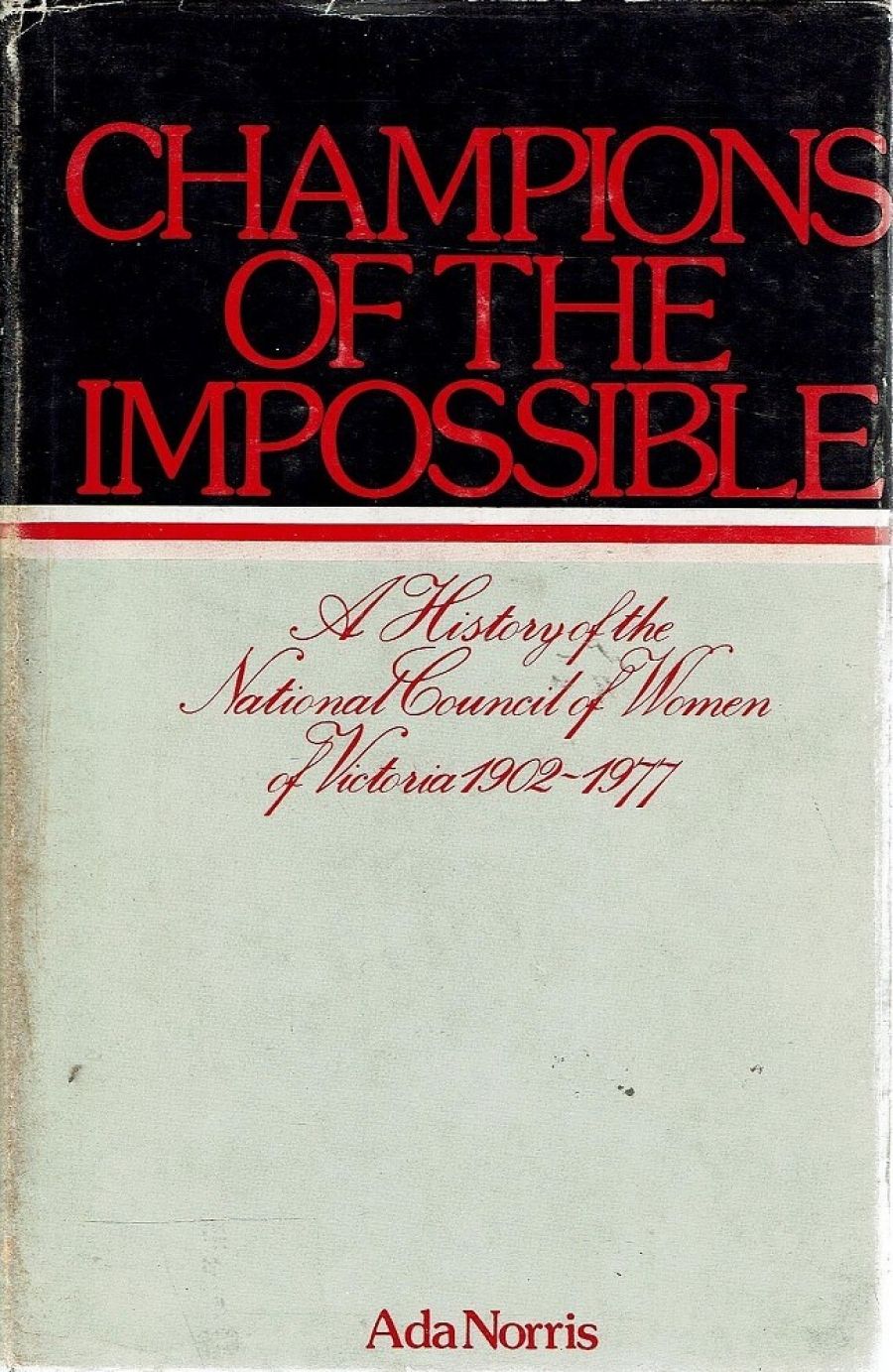
- Free Article: No
- Contents Category: Australian History
- Review Article: Yes
- Article Title: Impossible or inevitable?
- Online Only: No
- Custom Highlight Text:
One might question the appropriateness of this book’s title. Were women’s groups in the first half of this century championing impossible causes, or were they champions of the inevitable? In other words, to what extent did the organised women’s movement, or first-wave feminists, actively bring about legislative change to improve the position of Australian women, or might these changes have occurred anyway, the inevitable consequences of improved technology enabling women to plan their working lives?
- Book 1 Title: Champions of the Impossible
- Book 1 Subtitle: A history of the National Council of Women of Victoria 1902–1977
- Book 1 Biblio: Hawthorn Press, $12.50, 221 pp
Champions of the Impossible is an account of the establishment and growth of the National Council of Women of Victoria, a branch of the International Council of Women formed in Washington in 1888 with links back to the earlier Seneca Falls convention on women’s rights. While the author deftly traces the history of the women’s rights movement both overseas and in Australia, her focus is the Victorian branch of the Council. The Council was set up, not as an institution but as a forum and coordinating body for various women’s philanthropic, cultural and reformist groups. Beginning with thirty-five bodies each sending two representatives, the Council in Victoria by 1977 had 138 affiliates and some nine country branches. The book is organised chronologically. It traces the formation and early work of the Council which included demands for women police, magistrates and jurors, for a widow’s pension, uniform marriage and divorce laws, and representation on state and federal bodies. The Council also made its contribution to civic life: it organised a special display for Victoria’s 1934 centenary celebrations, and in March 1939 it set up a Women’s Voluntary National Register which it maintained until the Defence administration took it over in 1943.
Since World War II, the Council has carried on a similar range of activities. It established an Old People’s Welfare Council of Victoria; it intervened in a 1953 basic wage case and opposed the Chamber of Manufacture’s move to reduce the female basic wage from seventy-five to sixty per cent of the male basic wage (later it intervened in equal pay hearings); it formed the Victorian Children’s Book Council and helped set up a state branch of the Local Government Women’s association; it pressed for the right of women to sit on juries, and for amendments to the law on married women’s property rights, and questioned the exclusion of women from sporting clubs.
But what of the women whose organisations were affiliated to the NCW? They were, predictably, professional women – doctors, lawyers, teachers – or they were all well-to-do society women. Modern feminists might dismiss the efforts of women who called themselves ‘Mrs. Simon Fraser, Mrs. Herbert Brookes’ and even the author who is ‘Mrs. J.G.’, rather than ‘Dame Ada’, in the book. To do so, however, is to judge these women harshly. They reflected the social and economic mores of their time. Nice married women, unless they were professionals, didn’t work. Moreover, working class women lacked the time, and perhaps inclination, to join organised women’s groups.
The truth is that the Australian women’s movement always was, and still is, solidly middle class. Ada Norris does not apologise for the type of membership. She acknowledges that early NCW presidents were ‘leisured’ women, with domestic help and time to devote to voluntary work. After World War Two all that changed. ‘The next series of presidents would not have complete home help or their own private secretaries. They would be younger women, with home duties of their own, children at school, and busy husbands.’
While the Council’s membership remained middle-class, its ideas about the position of women in society, especially married women, were changing. In 1965 the Hon. (later Sir) William McMahon, Minister for Labor, told members he had changed his ideas about women being in the home only: ‘the emotional and psychological forces behind women in the workforce must be applauded, as well as their contribution to the expanding economy… we have found wonderful source of energy and power’. McMahon’s comments again raised the issue of whether improved status was an inevitable by-product of technological change, once women are indispensable in the work force.
The book’s major weakness is poor organisation. The chronological approach makes for dull reading. We follow the Council’s work, year by year, which leads to repetition and overlapping. It might have been better to take a thematic approach, tracing the Council’s fight on particular issues. The one attempt at this, the chapter on ‘The Nationality of Married Women’, works well. It might have worked too for issues such as women and the law, equal pay, the NCW and the community, and the rights of children.
Another flaw is failure to discuss the NCW’s work in relation to other women’s. reformist bodies, for example, the Australian Federation of Women Voters which campaigned along similar lines.
A further problem is the author’s unwillingness to question the middle-class character of the Council, and of the women’s movement generally. She assumes that the NCW represented a majority interest when it pressed for legislative change.
Despite these shortcomings, Champions of The Impossible is a valuable record of the work and aspirations of one of Australia’s early reformist women’s groups. Second-wave feminists tend to play down the merits of such organisation. But they are unfair: the achievements of early women s groups must be judged in their context – an age of ‘leisure’, of limited technology, and of much less soul-searching about one’s lot in society.


Comments powered by CComment